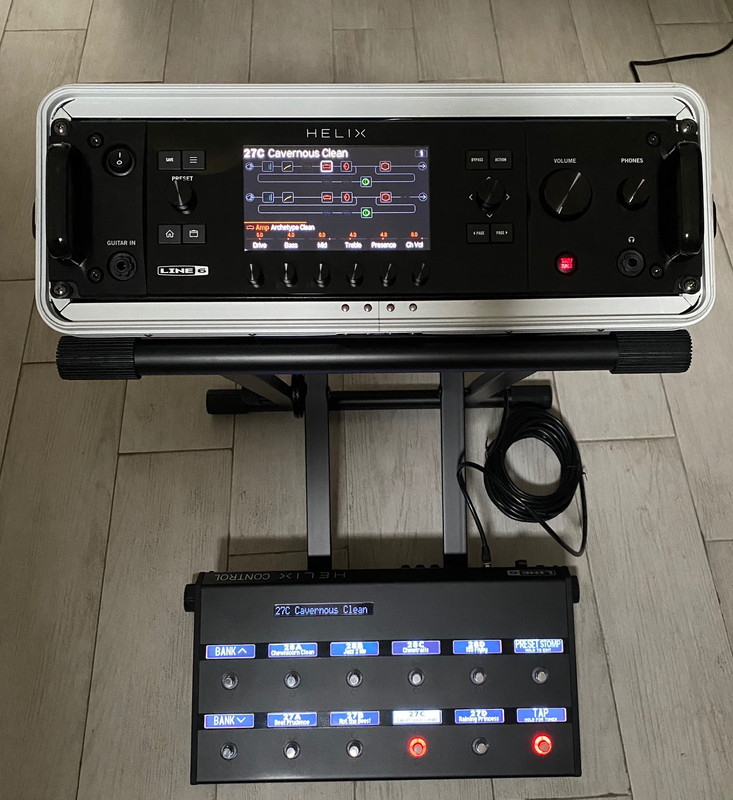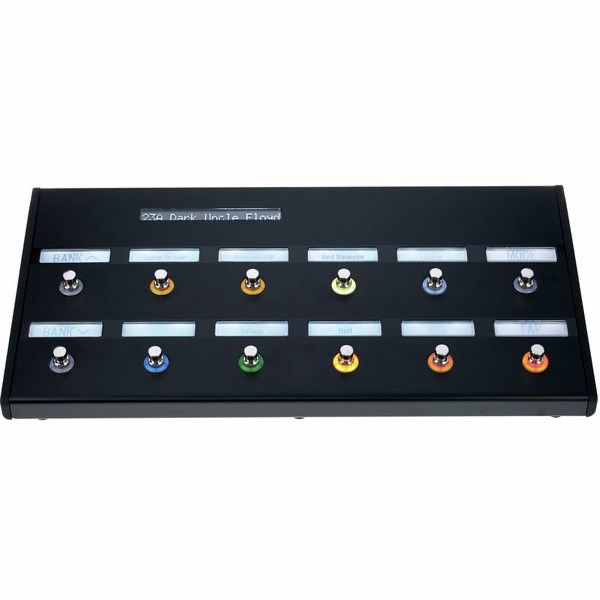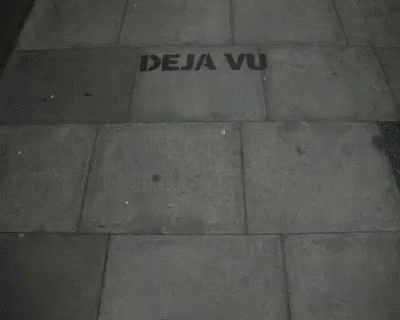-
Posts
1,689 -
Joined
-
Last visited
-
Days Won
83
Posts posted by PierM
-
-
I can confirm there is a bug on MacOS version that prevent HX Edit 3.5 to see the 3.6 update, and even if you manually install the HX Edit 3.6 it won't see the available 3.6 hardware update.
Use the Line 6 Updater app for the hardware.
-
 1
1
-
-
G10S is garbage. It's even worse then the smaller G10, as it uses a different system for the WiFi (even if using same freqs).
I did a lot of tests, in exactly same environment with G10S, G10 and Boss W20L
G10S drops out in Auto as well as in any other channel. Only way to make it working without drops is to use it in a desert.
G10 much more stable (it does drop out but less often than G10S), even if you have no control on the channel. Seems to better tolerate a busy WiFi area.
Boss WL-20L (grey one) it just works. Never had a drop out until now. Had the Boss WL-20 (the black one) with cable tone and returned as sounded awful for my ears, while the 20L (no cable tone) sounds spot on for my needs. They both works way better in a busy WiFi area than L6 relays.
So these days my G10S is grabbing dust in a closet, and I only use either the Boss or the old G10 with a G10TII as the original one has been ruined by the firmware.
-
On 5/8/2023 at 2:24 AM, Euripide said:
I was wondering if it is an indication that new models will be happening in a not so far future
....or if the entire line of guitar will be discontinued
My bet is; No and Yes.
-
A Helix Rack with wheels?
-
 3
3
-
-
Yes it's normal.
The top LCD on the Helix Rack foot controller isnt the same type as the scribble strips that are high contrast backlit. You can easily notice in any angled picture of the Control.



-
 1
1
-
-
it's because you are doing the tap dance barefoot. Just wear shoes or turn the touch off.
Read the manual. ;)
-
On 5/1/2023 at 1:36 PM, codamedia said:
I have seen statements like yours a lot of the forums, yet my HX Stomp never exceeds "warm", even after a 4 hour gig (sunlight excluded). I wonder how/why there would be such a discrepancy? My blocks are filled, but maybe I'm not running blocks that demand a ton of DSP.
I do live in south Italy. In summer we can easily go way over 45°C (113F). Stomp has zero vent ports, it's a sealed metal black box, with a tight pancake of PCBs in the inside, so if that case goes hot, the ambient temperatures and ventilation are playing a vital role in the heat dissipation.
Doesnt matter the block I use (i dont even use the amp modeling), it can gets really hot.
It doesnt hang or crash for me, but still that fan it's there to prevent potential conductance issues and inductor overheating.
-
 1
1
-
-
Im pretty confident the problem will disappear after the reset. :)
-
 1
1
-
-
On 4/30/2023 at 9:35 PM, w4lls said:
It's not that mate, I've had an LT, 2 Pod's, and a floor.
Fully expecting it to go bang shortly!
Maybe I will plug HX Edit back in over USB to speed things up!
Ouch...enjoy it while it lasts!-
 2
2
-
-
On 4/30/2023 at 9:19 PM, w4lls said:
Still working lol.
Just setup with my Mesa 5 50 4CM & setup a load of snapshots and still going.
No usb connected.
Hmmmmm lol...
The first cause of Helix/HX problems is....user errors. :)
So it could be you were just missing something in your early attempts.
When we help over here, we always assume you are doing all right, and that your systems are properly setup, but every time there is USB involved, a lot of extra variables are playing in the game...
Fingercrossed. :)
-
 1
1
-
-
It should work. I had one for couple of weeks (that I returned as imho was sounding awful).
The audio you hear when it's booting it's the analog pass thru. Is it working with a standard cable?
Are you using the original HX Stomp power supply?
Also try with a mono adapter (female to male) as that TRS jack can create issues with the TS at the HX stomp input.
-
Never heard this before neither I've ever seen that error.
I'd reset the unit as this isnt normal.
-
The Stomp is a "hot device" out of the box. It's an extremely tight package (it tends to overheat even in the studio) and over here, when it's hot summer, I use a 120mm fan to keep it in a safer range, that I've put under the pedalboard and powered with a 9V to 5V cheap converter. It helps moving a lot if air underneath and prevents the overheating.
A sunshield is also recommended.
-
On 4/29/2023 at 5:37 PM, datacommando said:
Ah, yes! It's like deja vu, all over again.
I thought it was too quiet in here - we were doing really well, but here we are after 4 days!
So, it begins - "Update bricked my Helix!"
I wonder how many have held back until the weekend to do this?
Let's hope it's the only one on this update.
And after all these years I wonder...how difficult it can be for L6 to just add few extra lines/pages of text in that damn error screen to help the user in the process? I mean, even just a link would be better than that "boot failure. entered update mode!"
-
 1
1
-
-

-
 1
1
-
 1
1
-
-
On 4/28/2023 at 10:37 AM, ACSlater said:
Yeah thought so.. too bad. It just so strange there's no possibility to up the brightness of the upper screen on the Rack Control.
@theElevators thanks for explaining but that's not the option I'm looking for; my question was specific about the Rack Control.Unfortunately the main top lcd in the Helix Control board isnt the same type of screens used for the scribble strips. They could work around that limit implementing the option to switch to inverted pixel color to improve contrast.
-
 1
1
-
-
On 4/27/2023 at 7:49 PM, brue58ski said:
The people that have Alexa in their homes really need to read 1984. So instead of the government forcing you to have big brother in your home. People are choosing to put it in voluntarily. Exactly the way the powers that be want it.
This is a bit of a boomer statement.
Alexa isnt sending any audio recording to anyone, unless you dont throw a command. Of course the system is "listening" to recognize when you use the trigger phrase, but that listening is just a local routine. If Alexa would send 24/7 an audio stream from any echo station running in the world, that would just blow up their servers.
Also, you can force the system to not store any audio, which means all is happening is just a data roundtrip; trigger phrase, request sent to server, answer sent back to client, data deleted.
It's 2023, soon AI will take over our daily jobs and govs already knows everything about us that needs to be known.
Life is too short to live wearing a tinfoil hat. :)
-
On 4/27/2023 at 1:46 PM, chumbo said:
Ah yes, should have mentioned it, it's a HX Stomp.
It's of course mainly a concern when gigging. Being on stage and browsing through presets and having all these changes in volume, noise of all sorts as I'm looking for the preset I want to load is pretty annoying I find.
Of course, I can think of a bunch of workarounds but it's not ideal, which is why I asked.
So it's not possible then...too bad :-(You shouldnt browse presets in a gig.
Use snapshots to create variations (seamless changes) within the same preset, or do your own presets setlist, with only presets you use, and balance them to work as you want. You can also place a volume block in each of them, to load at volume zero.
-
Sorry not going to open unknown hlx files, but check if that preset is using an iR block, with a missing iR file. This is a possible cause for noise because the amp block is hitting the output without a cab or an iR.
-
No, there is no way to prevent a preset being loaded, if you give the unit the time to load it.
If this is annoying you that much (honestly never had a problem like that in 8 years of daily use), you can place a cheap volume pedal in front of the helix, and turn the volume down while browsing, or use PCs to call only the presets you want.
-
 1
1
-
-
Always do a full hard disk alias on your desktop, as this is a quick and easy way to access the entire disk. If you use the stock finder as is, it can be misleading.. :)
-
 1
1
-
-
As I said, I was wildly assuming. No complains or being negative.
When I see no bug fixes for so many months/years, I start assuming the head programmers are busy and working on something else, while content guys are still there throwing goodies to keep the project alive, market wise.
Again, just saying based on what I've seen with HD and Firehawk and any other similar product or software I've worked with.
I'm happy with what I've, still, I'd rather have bugs and last gen OS drivers being released instead new stuff being added, but that's me - nobody cares really. :)
All good, I'm still enjoying my HX with 3.15.
-
 1
1
-
-
On 4/26/2023 at 1:11 PM, brue58ski said:
What is the HX project?
Everything that is based on the HX modeling technology.
-
3.60 update
in Helix
Reset the Globals.


HX EFFECT , POWER SUPPLY KO
in Helix
Posted
Over here in Europe the correct model name is Line 6 DC-3h Power Supply (9VDC, 3000mA).
https://www.musicstore.com/es_ES/EUR/Line-6-DC-3h-Power-Supply/art-GIT0054371-000?gclid=CjwKCAjw36GjBhAkEiwAKwIWyTU2ZLIq8jD_qKNsTSSPZ_7KTeTAf6l1Gpx3nQeLLc5nWsmv7FKh2xoChsAQAvD_BwE&campaign=GShopping%2FIT&ProgramUUID=ImjAqJarGRIAAAFl1OlyjI8x